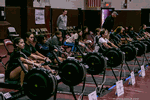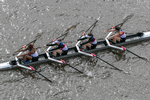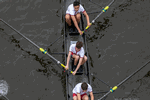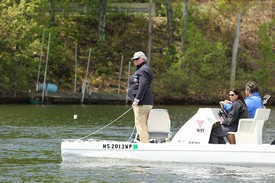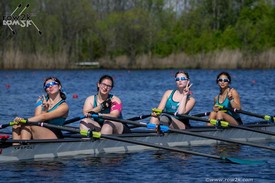Training Plans, Part 3: More Keys to Successful Plans
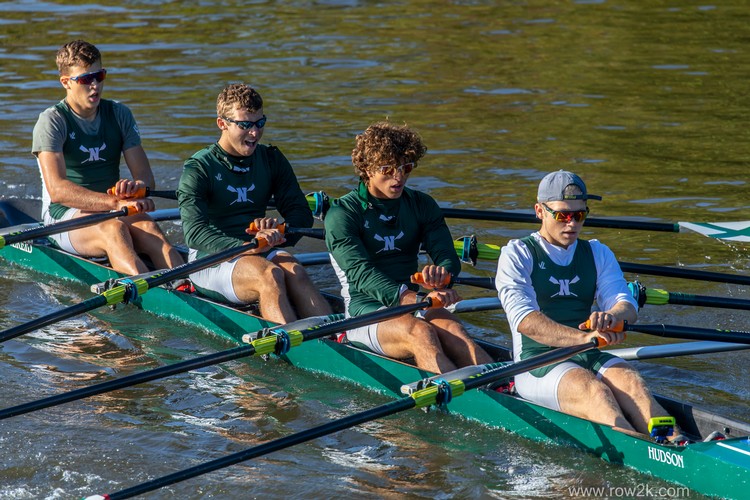
To learn more about this series and the topics we plan to cover, please visit the Youth Coaches Corner's index page. Youth coaches are more than welcome to contact row2k to get involved in future columns.
This week, we asked a second group of coaches about the key aspects of a successful training program for the kind of program--year-round, seasonal, scholastic, etc--they run. You can revisit the first round of answers here.
How many seasons does your team use for training during the year, and what are some of the most important aspects of a successful training program for your situation?
CATHERINE STARR - GREENWICH CREW - CO-HEAD WOMEN'S COACH
We practice year round, with some short breaks at the end of the fall and in the summer. We are lucky to be able to switch to early mornings in the summer in order to get the best water. We absolutely believe in the power of time off so we try to utilize our time wisely when we are in season.
Our definition of success in a training plan has adapted as we have grown our program and learned as coaches over time. We spent a good portion of our early years working out a way that we could enact a self-sustaining system where the athletes learned how to be athletes. The workouts were designed to show people what they are capable of.

Now our training plan has that element of getting kids to surprise themselves and reveal speed to themselves and their teammates while also focusing on the long term development of the athletes. Each year, the team needs something different so it’s a constant dialogue of what we’ve done and what we need to do. A key element is adapting to the athletes we have! The other marker of success is keeping athletes healthy and getting faster over the duration of their career.
GEORGE KIRSCHBAUM - JUNIORS COACH - AUTHOR OF 'THE DOWN AND DIRTY GUIDE TO COXING'
Most of the focus in my coaching career has been on scholastic programs whose only official season was in the spring from February through the end of May. There was the flexibility to run “winter conditioning” open to anyone in the school from November through February. The reality was that it was the crew kids training during that season, but also a chance to catch the interest of others in the school and pick up a few athletes. Outside of those two parts of the year, our kids did other sports or rowed for local clubs.
For me, it was having a base plan I’d use from year to year, starting in November, that could be adjusted to fit the needs of the athletes and our goals at the time. I think having measurable goals, whether on the erg or on the water, was key, but being wise enough and flexible enough to go in different directions as circumstances dictate was important.

MATT GRAU - THREE RIVERS ROWING - WOMEN'S HEAD COACH
Our team has a 42 week season that begins in late August and runs through either the Midwest Youth Championships or USRowing Youth Nationals based on performance. While we do have summer rowing programs, participation in these has no impact on school-year boat placement and typically focuses on boats that we don’t regularly row during the school year as a way to build more complete athletes. Given the climate of our region we stay on the water as long as it is safe to through the fall. We do commit ourselves to the erg for at least 9 weeks out of necessity. But we do try to get on the water as soon as it’s safe in the springtime. We have a plan for the whole year, and we tweak it where we need to given the weather.
Adaptability is the most important aspect; my guess is that most coaches would say that their water has a tendency to be challenging, and we certainly fall into that category. It is very important for our training program to be adaptable so that we can take advantage of good, safe water conditions when they are available. We have great on-land facilities, so making adjustments to our overall training program is absolutely possible. Our program pulls from a wide variety of schools, many of which have different breaks and holidays - so creating a training program that targets when we know that all of our athletes will be available is very important. I think that frequent monitoring, evaluation, and adjustment is essential to training programs.
JULIA HOWARTH - BAYLOR SCHOOL - HEAD WOMEN'S COACH
Both teams I have coached at in the US practice year round. At Mercer, we rowed for Fall and Spring, ran summer programming for the current team members (and had learn to row camps for potential new members) and then erged for the winter season. At Baylor, we are lucky: we can row year round because of the milder temperatures in Tennessee. Baylor is a school team, so we practice in the Fall, Winter and Spring. In the winter, we would typically lift, cross train, erg and row on the water as much as possible. Back home, in Australia, the weather is also mild so everyone rows year around on the water.

Utilizing every minute of practice time has been really important at both Baylor and Mercer. As part of a school, the Baylor athletes have other important commitments and you share your time with other school activities. At Mercer, as part of the Novice program, we were sharing space with other programs/teams and had to be mindful to keep to our allotted time. I feel that in both situations the athletes learn to be really efficient with practice and get the most out of each 2 hour practice. There is no dilly-dallying around: we get in, have a great practice, and go home.
DREW COMBS - LITCHFIELD HILLS ROWING CLUB - HEAD COACH
We are club program, so we run year round. Have to keep the lights on.
Specialization in sport stops our athletes from being athletes. Make sure to spend time getting rowers off the erg and out of the boat. Mix up training to avoid injury and make rowers all-around athletes. Sure: we won’t catch stuff very well, but we can still jump, lift, and move side to side.
Make it fun and challenging. We take a 6 week break from any rowing motion every winter; from late November to January, the youth athlete will not erg or row.
BEN WILLIAMS - RIVER CITY ROWING CLUB - VARSITY WOMEN'S COACH

I believe the key to a successful training plan for smaller clubs is making certain the plan matches the goal. If we have a big goal, we’ll have to do big things. If we have a small goal, we don’t have to do as much. Either way, it's pretty crucial to focus on the enjoyment of the process, and know why we're doing what we do.
In terms of traditional success, and getting on podiums in the late season, there are tons of factors, but the biggest ones I see set crews apart are adherence--are the athletes present and involved in the training?--and malleability--is the program dynamic enough that, if something changes, does it keep everything from falling apart?
My go-to and extremely paraphrased quote of "no good plan survives contact with reality" has held true time and time again for me. We go in with the plan as scaffolding, and then adapt based on how the bodies feel. If the fatigue doesn’t match the load, we pivot and try again. In the end, we’re all working together, so it’s paramount the coaches and athletes are aiming at the same targets.
ZACH SPITZER - NEREID BOAT CLUB - HEAD MEN'S COACH
Our team trains year round at our boathouse. We do have some athletes that are various teams in the winter, whether it be swimming or basketball. Summer is the smallest squad during the year, but the top rowers on our team are doing all 4 seasons with us.
We train different groups of athletes...differently. We have a more recreational side of the team, and those younger athletes are doing short work on the erg, more body weight circuits and playing games. Those athletes only workout/row 2-3 times a week. Once you make it onto our Novice team, they start practicing 5 days a week and start learning how to do workouts, and figuring out how to train rather than just come in hop on the water and get out.
Varsity athletes range in age, so we just try and keep tabs on what kind of training they are doing and how much. We generally group Freshman and Sophomores together and Juniors and Seniors in terms of training volume.
JOSH BAKER - ATOMIC ROWING - HEAD MEN'S COACH
Our primary seasons are the Fall, Winter and Spring but we do also offer both Learn-to-Row and High Performance Summer camps.
Number one is ensuring the health of our athletes by training smarter and not always harder, load management for athletes returning to rowing-specific training, and periodized training plans with incremental and intentional additions to volume and intensity. Second to that is having fun with our training and making the boathouse a place that athletes look forward to coming to. As long as those two objectives are met, we have a chance to train productively.
CATHY COFFMAN - ALBEMARLE HS - HEAD COACH
We are lucky here in Charlottesville in that there is a local rowing club that offers summer and/or fall programs for juniors in the area. Most of our rowers participate in those programs at the Rivanna Rowing Club. However, we encourage lots of cross training outside of the spring scholastic season. Many of our athletes do lots of cross training during the summer months – they swim, take bike trips, run, and/or hike. We also give our athletes breaks away from rowing several times a year. At the conclusion of the scholastic season, athletes have three weeks off before summer programs. At the end of the summer, they have another three weeks off. And finally, after the end of the head racing season, athletes have four weeks off. During each of these “off periods”, athletes are encouraged to rest for a week and then do light cross training for the remainder of the off period. These weeks away from the boathouse and rowing are essential for their mental health as well as a time to rest their adolescent bodies. Injuries are few and the athletes are excited about getting on the water again once the off periods are over!
In terms of training cycles, we use the summer to work on technique and have fun. Everyone has a chance to row in singles in order to practice flipping and boat maneuvers. Club rowing in the summer allows athletes to meet folks from all over the area, not just their scholastic team. The focus during the summer months isn’t on racing (though the athletes may occasionally attend a race or two). During the winter months, we build volume on the erg and do weight circuits about twice a week. The focus is form on the erg, developing overall strength, and learning how to work hard while developing fitness and technique. Once the spring rolls around, the athletes have an adequate base to begin to develop higher ratings in preparation for racing. We have also found that the volume and intensity on the erg during the winter months help develop racing confidence in the athletes.

If you enjoy and rely on row2k, we need your help to be able to keep doing all this. Though row2k sometimes looks like a big, outside-funded operation, it mainly runs on enthusiasm and grit. Help us keep it coming, thank you! Learn more.
Comments | Log in to comment |
There are no Comments yet
| |
- Bont Rowing
- Calm Waters Rowing
- Concept 2
- Craftsbury Sculling
- The Crew Classic
- CrewLAB
- Croker
- Dad Vail Regatta
- Durham Boat Co.
- Empacher
- Faster Masters
- Filippi
- Fluidesign
- h2row.net
- HUDSON
- Live2Row Studios
- Nielsen-Kellerman
- Oak Ridge RA
- Peinert Boat Works
- Pocock Racing Shells
- Race1 USA
- Rockland Rowing Masters Regatta
- RowKraft
- Rubini Jewelers
- Vespoli USA
- WinTech Racing
- Bont Rowing
- Calm Waters Rowing
- Concept 2
- Craftsbury Sculling
- The Crew Classic
- CrewLAB
- Croker
- Dad Vail Regatta
- Durham Boat Co.
- Empacher
- Faster Masters
- Filippi
- Fluidesign
- h2row.net
- HUDSON
- Live2Row Studios
- Nielsen-Kellerman
- Oak Ridge RA
- Peinert Boat Works
- Pocock Racing Shells
- Race1 USA
- Rockland Rowing Masters Regatta
- RowKraft
- Rubini Jewelers
- Vespoli USA
- WinTech Racing



